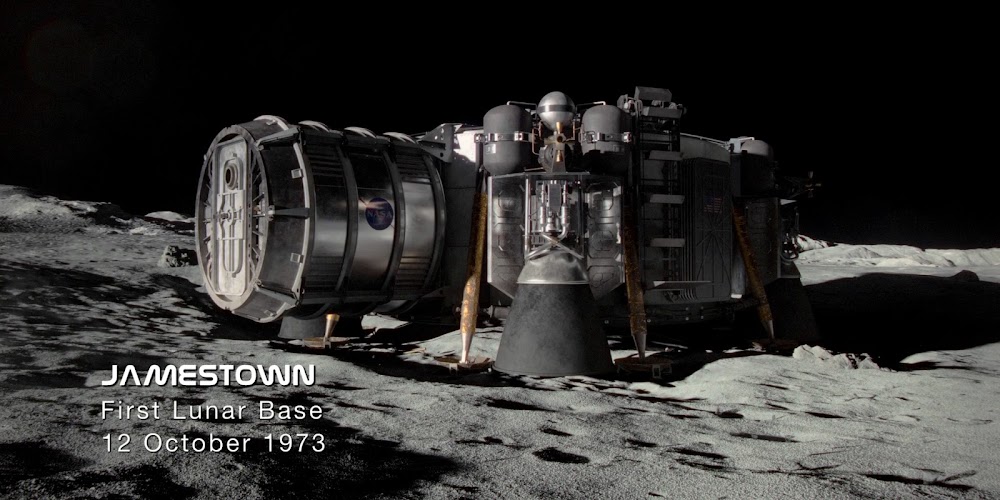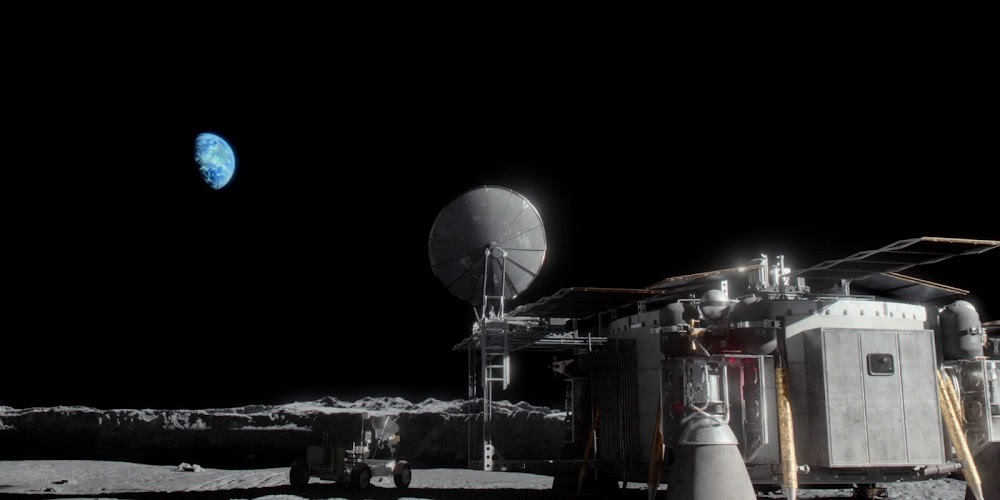In addition to today's announcement, NASA shared latest official render of SpaceX's Lunar Starship which slightly differs from last year's version:
Friday, April 16, 2021
NASA selects SpaceX Lunar Starship to return humans to the Moon
Today NASA announced it has selected SpaceX "to continue development of the first commercial human lander that will safely carry the next two American astronauts to the lunar surface" as part of the Artemis program. A year ago it was announced three contenders were selected to compete for this mission - SpaceX, Blue Origin's led "National Team" and Dynetics - and SpaceX revealed it is working for a lunar optimized Starship. Now we know SpaceX's proposal has won the race. In a milestone-based fixed-price contract SpaceX will be able to receive $2.89 billion to develop the Lunar Starship. The year when SpaceX needs to land humans back to the Moon is not specified yet.
Tuesday, April 13, 2021
Brutalist architecture in Martian science fiction
Brutalism is an architectural style that emerged in the 1950s and grew out of the early-20th century modernist movement. Brutalist buildings are characterized by their massive, monolithic and "blocky" appearance with a rigid geometric style, large-scale use of poured concrete and a predominantly monochrome color palette. The style was popular in 1960s and 1970s in the West and well into 1980s in communist countries and Latin America.
As Brutalism started with an ethos of social utopianism but ended with associations of being cold, inhuman and totalitarian, no wonder it is the most dominant architectural style in dystopian fiction. But it is present also in general science fiction when envisioning a city in future.
One of the flaws of most Brutalist buildings is associated with weather effects on raw concrete, especially in wet and cold climate. Thus, despite being massive and seemingly long-lasting, most of Brutalist buildings are in poor condition today. But it's not a concern on Mars with its dry climate preserving rocks for billions of years. That is one of the reasons movies, TV series, games and art portraying human colonies and bases on Mars is filled with buildings in Brutalist style. Although the truest reason could be that Brutalist architecture with its simple shapes and monochrome colors can be easily reproduced in art, computer graphics and film sets :)
Here are some examples of Brutalist architecture in movies, TV series, video games and art set on Mars:
As Brutalism started with an ethos of social utopianism but ended with associations of being cold, inhuman and totalitarian, no wonder it is the most dominant architectural style in dystopian fiction. But it is present also in general science fiction when envisioning a city in future.
One of the flaws of most Brutalist buildings is associated with weather effects on raw concrete, especially in wet and cold climate. Thus, despite being massive and seemingly long-lasting, most of Brutalist buildings are in poor condition today. But it's not a concern on Mars with its dry climate preserving rocks for billions of years. That is one of the reasons movies, TV series, games and art portraying human colonies and bases on Mars is filled with buildings in Brutalist style. Although the truest reason could be that Brutalist architecture with its simple shapes and monochrome colors can be easily reproduced in art, computer graphics and film sets :)
Here are some examples of Brutalist architecture in movies, TV series, video games and art set on Mars:
In movies and TV series
One of the most famous Martian movies - Total Recall (1990) - has some of the purest examples of Brutalist architecture, although most of them in scenes on Earth (filmed in Mexico City):
Monday, April 12, 2021
Mars base by Mark Garlick
Picture of the Day 12/04/2021 - an early human base on Mars by British illustrator Mark Garlick. More of his art here. Note the Spirit/Opportunity rover in the field.
Monday, April 5, 2021
First humans on Mars
Young Irish 3D artist Matthew Ryan has created a stunning animation of a SpaceX's Starship getting people from Earth to Mars for the first time ever. Here is the final scene with a group of Starmen disembarking from Starship on Mars:
Full animation here:
Thursday, April 1, 2021
SpaceX Starship interior concept for 100 passengers by Joseph Lantz
Joseph Lantz has created his concept for the interior layout of SpaceX's 100-passenger Starship (the passenger capacity goal stated by Elon Musk). Therefore this concept isn't meant for the first crew Starships on Mars used as temporary habitats for the first few years (those first Starships will have much smaler crew). The concept divides the pressurized living space into 8 decks (here shown from top to bottom) and follows a common design choice of a central stairway through all the decks.
Deck 8 - Observation
Tuesday, March 30, 2021
Astronaut relaxing near a SpaceX Starship spaceport
Picture of the Day 30/03/2021 - Astronaut leaning against his Mars rover derived from a retro car near a SpaceX Starship spaceport by American video game concept artist Darren Bacon in collaboration with parody account Bored Elon.
Monday, March 29, 2021
Jamestown US Moon base in season 1 of "For All Mankind" TV series
For All Mankind is alternate history sci-fi TV series depicting what could have happened if the space race had never ended after the Soviet Union succeeds in the first crewed Moon landing ahead of the United States in 1969. The authors of the show speculate such an event would force US to double down on space exploration altering the Apollo program from "flags and footprints" approach to a more ambitious one with extensive infrastructure buildup on the Moon (with hints of Mars exploration in later seasons of the show). Pouring money and resources into space exploration creates an atmosphere every space nerd would have wanted to continue after the enthusiastic 1960s.
Season 1 of the series (aired in 2019) depicts events from 1969 to 1974 in the alternate timeline of For All Mankind. The series are in the middle of season 2 now depicting the alternate 1983. It was said each season of the show will jump about a decade further into the increasingly diverging reality of the show. We will feature season 2 here after it will be aired completely. So here is a collection of HD images from season 1 with a focus on US Jamestown lunar base at the rim of Shackleton Crater near the lunar South pole where water ice is discovered in 1970 (several decades earlier than in reality):
Season 1 of the series (aired in 2019) depicts events from 1969 to 1974 in the alternate timeline of For All Mankind. The series are in the middle of season 2 now depicting the alternate 1983. It was said each season of the show will jump about a decade further into the increasingly diverging reality of the show. We will feature season 2 here after it will be aired completely. So here is a collection of HD images from season 1 with a focus on US Jamestown lunar base at the rim of Shackleton Crater near the lunar South pole where water ice is discovered in 1970 (several decades earlier than in reality):
Landing of the initial Jamestown lunar base module in October 1973:
Jamestown Phase 1 US lunar base in 1974:
Sunday, March 21, 2021
Martian colonies in season 5 of The Expanse
Mars is one of the three competing powers in universe of The Expanse TV series - a political sci-fi drama set a few centuries in the future where humans have colonized the entire Solar system. Mars, governed by Martian Congressional Republic, is a militaristic and technologically advanced society of over nine billion inhabitants. Martian society had been highly mobilized towards the shared goal of terraforming Mars for over a century but in season 4 that shared goal and order of the Martian society was starting to erode as the new habitable planets beyond the rings were discovered and people realized they could build a new home there without the costly need of terraformation. That erosion continues in season 5.
In Martian scenes of season 5 the show focuses on depicting Asteria Naval Base (or Asteria NB) which is a military base and war college of the Martian Congressional Republic Navy (MCRN). Here is a collection with HD images from the Martian scenes in season 5 of The Expanse (open link in new tab to view in full resolution).
In Martian scenes of season 5 the show focuses on depicting Asteria Naval Base (or Asteria NB) which is a military base and war college of the Martian Congressional Republic Navy (MCRN). Here is a collection with HD images from the Martian scenes in season 5 of The Expanse (open link in new tab to view in full resolution).
Exterior and interior of the Asteria Naval Base:
Martian mass transit network crosses canyons on cables and runs deep under ground:
Saturday, March 13, 2021
СССР-2061 - a retrofuturistic vision of Soviet Union on Mars
Project "СССР-2061" is a community of Russian artists and writers envisioning Soviet Union in 2061 in an alternate reality. In 2011 they held their 1st arts contest asking participants to envision Soviet Union on Mars 50 years into the future. Here are some of the artworks from the contest.



Soviet spaceport in Valles Marineris on Mars by Igor Savin:


Domed soviet colony on Mars by Grinya Lesnoy:

Thursday, March 11, 2021
SpaceX Starship landing on Mars by Kendall Dirks
Subscribe to:
Posts (Atom)

 Today
Today 


















